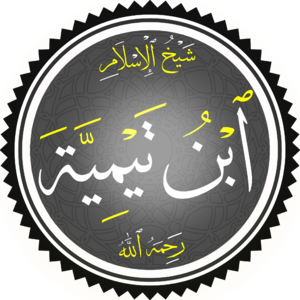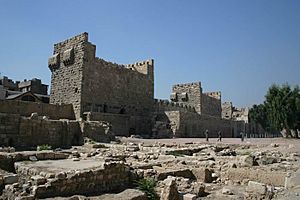Ibn Taymiyya facts for kids
Quick facts for kids Ibn Taymiyya |
|
|---|---|
| ابن تيمية | |

Calligraphy of Ibn Taymiyya's name
|
|
| Religion | Islam |
| Denomination | Sunni |
| Alma mater | Madrasa Dar al-Hadith al-Sukariyya |
| Personal | |
| Born | 22 January 1263 CE 10 Rabi' al-Awwal 661 AH Harran, Mamluk Sultanate (modern-day Turkey) |
| Died | 26 September 1328 CE (aged 65) 20 Dhu al-Qa'da 728 AH Damascus, Mamluk Sultanate (modern-day Syria) |
| Senior posting | |
| Title | Shaykh al-Islām |
| Influenced |
|
Ibn Taymiyya (born January 22, 1263 – died September 26, 1328) was an important Sunni Muslim scholar and jurist from the Middle Ages. He was known for his strong beliefs and for trying to bring back what he saw as the original teachings of Islam. He lived during a time when the Mongol Empire was very powerful and often fought against Muslim lands.
Ibn Taymiyya was a Hanbali jurist, which means he followed a specific school of Islamic law. He often disagreed with other scholars and rulers about religious practices. This led to him being imprisoned several times. He is famous for his role in stopping the Mongol invasions of Syria. He even spoke directly to the Mongol ruler, Ghazan Khan.
His ideas have been very influential in later centuries, especially for movements that want to return to the ways of the early Muslims. He wrote many books and essays, sharing his views on Islamic law, theology, and society.
Contents
Who was Ibn Taymiyya?
Ibn Taymiyya's full name was Taqī al-Din Abū al-ʿAbbās Aḥmad ibn ʿAbd al-Ḥalīm ibn ʿAbd al-Salām ibn ʿAbd Allāh al-Numayrī al-Ḥarrānī. He was also known by the title Shaykh al-Islam, which means "leader of Islam."
His Early Life and Education
Where did Ibn Taymiyya grow up?
Ibn Taymiyya was born on January 22, 1263, in Harran, which is now part of Turkey. His family was well-known for being scholars of the Hanbali school of thought. Both his father and grandfather were respected religious teachers.
In 1269, when he was seven years old, his family had to leave Harran. The city was destroyed by the Mongols. His family moved to Damascus, in Syria, which was then ruled by the Mamluk Sultanate.
How did Ibn Taymiyya learn?
In Damascus, Ibn Taymiyya's father became the head of a school called Sukkariyya Madrasa. Ibn Taymiyya studied there and learned many subjects. He memorized the entire Quran and learned about Islamic law (called fiqh). He studied the works of famous scholars like Ahmad ibn Hanbal.
He also learned about Arabic language, math, history, and philosophy. He studied with over 200 teachers, including four women. By the age of 17, he was allowed to give legal opinions, becoming a mufti. He finished his education when he was 20 years old in 1282.
Life as a Scholar and Teacher

After his father passed away in 1284, Ibn Taymiyya took over his teaching position. He taught lessons on Hadith (sayings of the Prophet Muhammad) and tafsir (explaining the Quran) at the Umayyad Mosque.
He traveled for the Hajj (pilgrimage to Mecca) in 1292. After returning, he wrote his first book. In this book, he criticized some new religious practices he saw during the pilgrimage.
Ibn Taymiyya lived a simple life. He never married and spent most of his time learning, writing, and teaching. He was offered official positions but always refused them.
How did Ibn Taymiyya get along with rulers?
Ibn Taymiyya's relationship with the rulers was not always easy. Sometimes they agreed, and his advice was welcome. But when he disagreed with the government or common practices, he was seen as difficult. He believed it was his duty to speak the truth, even if it meant facing problems.
He was imprisoned six times, spending more than six years in jail. These imprisonments often happened because other religious scholars and Sufi leaders disagreed with his strong views. They sometimes convinced the government to limit his influence.
His public life began in 1293 when he was asked to give a fatwa (legal opinion) about a Christian cleric accused of insulting Prophet Muhammad. Ibn Taymiyya said the man should be punished with death. When the governor tried to resolve it differently, Ibn Taymiyya protested. This led to his first imprisonment.
Fighting the Mongol Invasions
How did Ibn Taymiyya help against the Mongols?
Ibn Taymiyya played a very important role during the Mongol invasions of Syria. The Mongols had conquered many lands and were a great threat.
In 1299, the Mongol army defeated the Mamluks and reached Damascus. Many people fled, but Ibn Taymiyya stayed. He encouraged the people of Damascus to resist the invaders. He told them that fighting the Mongols was a religious duty.
He even went with a group of scholars to speak with the Mongol ruler, Ghazan Khan. He asked for the release of Muslim and Christian prisoners taken by the Mongols. After negotiations, he successfully secured their freedom.
What was his famous ruling against the Mongols?
In 1303, during another Mongol invasion, Ibn Taymiyya issued a very important fatwa. He said that fighting the Mongols was not just allowed, but it was a religious duty for all Muslims. He argued that even though the Mongols claimed to be Muslim, they did not rule by Islamic law (Sharia). Instead, they used their own traditional laws (called Yassa). Because of this, he believed they were not true Muslims.
This fatwa was groundbreaking because it allowed Muslims to fight against others who claimed to be Muslim but did not follow Islamic law. Ibn Taymiyya personally joined the Battle of Marj al-Saffar against the Mongols. He even carried a sword and led his students in the fight. The Mamluks won this battle, ending Mongol control of Syria.
His actions and rulings during the Mongol invasions made him very respected among the people.
His Later Years and Imprisonments
Why was Ibn Taymiyya imprisoned for his beliefs?
Ibn Taymiyya was known for strongly disagreeing with many religious groups and ideas of his time. He believed they were wrong and caused problems in the Muslim world. He was imprisoned several times because his views were different from what most scholars believed.
One of his books, Al-Aqidah Al-Waasitiyyah, caused a lot of trouble. In this book, he wrote about how God should be described, based on the Quran and Hadith. He believed all Muslims should follow this view. Other scholars accused him of describing God in a way that made Him seem too human (called anthropomorphism).
He faced several hearings and debates about his beliefs. Even though some judges found him innocent, he was still imprisoned in Cairo in 1306. He was released after about a year but was not allowed to return to Syria.
Why was he imprisoned for his views on intercession?
Ibn Taymiyya also had strong views on tawassul (asking for help through someone else, like a prophet or saint). He believed that people should only ask God directly for help, except on the Day of Judgment. This disagreed with many Sufi leaders and common people who believed intercession was allowed in other situations.
Because of these disagreements, he was imprisoned again in Cairo in 1308. After his release, he stayed in Egypt for five more years. He was even placed under house arrest in Alexandria for seven months. During this time, he wrote an important book called Al-Siyasa al-shar'iyya, which discussed the role of religion in politics.
When did Ibn Taymiyya return to Damascus?
In 1313, at the age of 50, Ibn Taymiyya returned to Damascus. He continued teaching Islamic law. One of his most famous students, Ibn Qayyim Al-Jawziyya, studied with him during this time.
Why was he imprisoned for his views on divorce?
In 1318, Ibn Taymiyya issued a fatwa about divorce. His view made it harder for a man to divorce his wife easily. He disagreed with the common practice where saying "I divorce you" three times in one go counted as three separate divorces. He believed it only counted as one divorce if the intention was not to divorce three times.
This view was very controversial and went against the opinions of most scholars at the time. Even though the sultan had forbidden him from issuing fatwas on this topic, Ibn Taymiyya continued, saying he could not hide his knowledge. This led to him being imprisoned again in the Citadel of Damascus in 1320. He was released about five months later.
What was his final imprisonment about?
Ibn Taymiyya wrote a book about visiting the tombs of prophets and saints. He believed that traveling with the only purpose of visiting a grave, even Prophet Muhammad's, was a new religious practice that was not good. For this view, he was imprisoned for the last time in the Citadel of Damascus on July 18, 1326, when he was 63 years old. His student, Ibn Qayyim, was also imprisoned with him. The sultan also told him not to issue any more fatwas.
His Death
Ibn Taymiyya became ill in early September 1328 and passed away on September 26, 1328, at the age of 65, while still in prison. When news of his death spread, thousands of people came to show their respect. It is said that hundreds of thousands of men and thousands of women attended his funeral prayer. This was one of the largest funerals in Islamic history, showing how much people respected him.
He was buried in Damascus, in a cemetery called Maqbara Sufiyya.
Who were Ibn Taymiyya's students?
Many of Ibn Taymiyya's students became important scholars themselves. They came from different backgrounds and followed different schools of thought. The most famous ones are Ibn Qayyim al-Jawziyya and Ibn Kathir. Other notable students include:
- Al-Dhahabi
- Jamal al-Din al-Mizzi
- Ibn Abd al-Hadi
- Ibn Muflih
- Imad al-Din Ahmad al-Wasiti
- Najm al-Din al-Tufi
- Al-Ba'labakki
- Al-Bazzar
- Ibn Qadi al-Jabal
- Ibn Fadl Allah al-Amri
- Muhammad ibn al-Manj
- Ibn Abd al-Salam al-Batti
- Ibn al-Wardi
- Umar al-Harrani
What did Ibn Taymiyya write?
Ibn Taymiyya wrote a huge number of books and essays. Some scholars say he wrote around 700 works. His writings covered many areas of Islamic knowledge. In his early life, he focused on theology and using reason to understand religious texts. Later, he wrote about criticizing Greek philosophy, questioning common practices, and debating with Christians and Shia Muslims.
Not all of his works have survived, but his existing writings fill many volumes. His ideas became very popular again starting in the 18th century, and many of his books were published and shared widely.
Some of his famous books include:
- Majmu' al-Fatawa al-Kubra – A large collection of his legal opinions.
- Minhaj al-Sunna al-Nabawiyya – A book where he debated with Shia doctrines.
- Al-Aqida al-Wasitiyya – His important book on Islamic beliefs.
- Al-Jawab al-Sahih li-man Baddala Din al-Masih – A book responding to Christianity.
- Al-Sarim al-Maslul ala Shatim al-Rasul – Written after he heard someone insulting Prophet Muhammad.
- Al-Siyasa al-Shar'iyya – A book about the role of religion in government.
Some of his works translated into English:
- The Friends of Allah and the Friends of Shaytan
- Kitab al-Iman: The Book of Faith
- Diseases of the Hearts and their Cures
- The Relief from Distress
- Fundamentals of Enjoining Good & Forbidding Evil
- The Concise Legacy
- The Goodly Word
- The Madinan Way
- Ibn Taymiyya against the Greek Logicians
- Muslims Under Non-Muslim Rule
Images for kids
See also
 In Spanish: Ibn Taymiyya para niños
In Spanish: Ibn Taymiyya para niños




